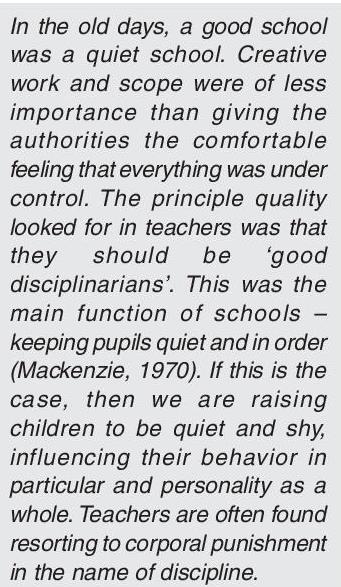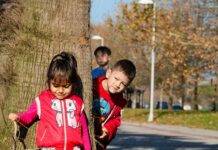Learning From Children: How They Want Their Teachers To Be
No research on pedagogy can be complete unless it takes into account the ideas of children and their expectations from their teaches. In the revealing piece that follows we will walk through some of the deep insights that children have themselves shown us to make education a more holistic experience for both the teacher and the pupil.
Pooja Maggu is a Ph.D. scholar at University of Delhi.
Dr Shraddha Kapoor is Associate Professor at Lady Irwin College.
Children spend a large part of their childhood in school. Considering how important the role of the immediate environment is in the child’s development, the role of schools and adults cannot be ignored. Schools have been considered as indispensable institutions in all kinds of societies. The experience that one encounters at school, in interaction with peers and teachers, apparently has an important role to play. Experiences at school can have an impetus on the child’s thoughts and behavior. There seems to be a dearth of research work that focuses on children’s voices exclusively. Thus, it appeared imperative to find out from children themselves how they felt at school. This article would help to understand the problem through the perspective of a child; as to what constitutes a school. This article is written on an idea that it could be a child who can better educate a teacher about what it takes to facilitate learning and creativity in classrooms. Let’s forget, for the time being, what ‘we’ as adults have to share and concentrate on what ‘children’ have to say. I, therefore, in the paragraphs below attempt to make recommendations using children’s ideas.
This article is based upon a single tool administered on 72 children from Delhi and Meerut, a city in Uttar Pradesh. These findings are a part of my Doctoral research that aims to explore emotional experiences of children and how these experiences influence their behavior at school, as perceived by them. In the light of schooling, children often encounter some situations that evoke various emotions in them. These emotions apparently influence children’s thoughts and behavior. During data collection- extensive classroom observations, dialogues with children and teachers, and using children’s drawings and narratives, there emerged important findings implying significant connotations to the world of ‘school’ and ‘children’. This article is however limited to one of the statements given; aimed to explicit children’s feelings of being at school.
It seemed interesting to find out what children think teachers should do; and thus to gather their expectations from a teacher, they were asked to complete a sentence given to them stating “Teachers should………………”. It seems to be a well known fact that teachers form one of the most significant adults in a child’s life, beyond family. There has been enough research that endorses the importance of positive teacher-child relationships at school. It seems important to note here, a study by Poplin & Weeres (1994) that explored the thoughts of students, teachers, cafeteria workers, security guards, parents, administrators and others to find out the problem with schooling. The problem identified was related to relationships at school especially the relationships between teachers and students. A positive relationship between the children and teachers is certainly important to build a happy classroom. Even Gable (2002) mentioned, “From the children’s perspective, however, the single most meaningful characteristic is probably the relationship that children have with their teachers” (p. 42).






Coming to what children had filled the given sentence with, the majority of children simply stated, “Teachers should be good”. Good, however subjective, is a positive term. Explicitly expressed by some children; the actual traits that they would like to find in their teachers, such as being kind, cooperative and understanding. Expressed by 11 children, another major trait that emerged was ‘being polite’. As one of them wrote, “Teachers should be told to talk softly to children”. They have expressed feeling sad when teachers are harsh or rude to them. Ironically, children are told moral stories in school, to inculcate values of being kind, helpful, polite etcetera, but here we have children telling us, the need to build same values in the teacher.
Majority children also said that they would like to see their teachers as friends, with whom they can share their feelings; ask questions, in doubt; and in presence of whom, they are not scared. Evans (2014) mentioned how teachers should act more as ‘friends’ than experts or guides. Children seem to prefer a friendly teacher over a strict one- one who often laughs with children. There is a need to tell children that they are being loved and appreciated. A positive and effective teacher-child relationship at school helps the child to actively engage themselves in learning activities, without getting scared.
Three children wrote, “Teachers should love us”. The need for affection thus emerged, directly from children. It is important to bring in the element of ‘affection’ or ‘love’ in class so that children are happy at school. It is also important to note what Russell (2010) has to say about affection. He said, “Affection…is much more likely to exist where there is happiness and absence of fear” (p. 131).
Two children said, “Teachers should be happy”. Another child said, “Teachers should not be angry”. Students, however, learn and perform better when they feel secure, happy, and excited about the subject matter. Bloom (2014) also talked about teacher’s well-being and happiness as central to students’ academic development. Happy and optimistic teachers are more likely to achieve higher academic results from their students than those who are stressed and sad. Besides the academic results, teacher’s happiness is seen to have a significant effect on student’s emotional adjustment too.
Interesting it is, to find that when given a statement like ‘teachers should’; children added a word- ‘not’- across to change its implication. Thus, in an endeavor to find ‘what teachers should’, the study also helped to explore ‘what teachers should not’. Six children stated teachers should not hit or beat them. Three children said, “Teachers should not scold us”. Besides being banned, the same seems to be still practiced by some teachers in the school. Corporal punishment still remains a sad fact of school’s life. However, one child said, “Teachers should not be dangerous”. When asked what she means by the statement, she said, “I am scared of her, (you) never know when she might just hit (me)]”
Ballal (2010), in a newspaper article reported Dr. Helen Williams saying, “When we beat children as a form of discipline, we may well be teaching them that it is okay to hit someone. That people can dominate you. That one has to do what one is told and not think for oneself and that it is okay to act in anger. Isn’t beating a child an example of a teacher who has literally given up on all other means of educating a child? Children at this age like going to school not because they love math or geography but because their teachers teaches well and they like her”.
It appeared quite obvious from the children’s responses that they are scared expressing themselves to the teachers. Children go through an array of emotions in school and their emotional experiences with teachers influence their behavior too. Fear, for example do not let them to express their feelings completely, as they are scared to make any mistake. To save themselves from being scolded or beaten, children prefer to keep quite. In the old days, a good school was a quiet school. Creative work and scope were of less importance than giving the authorities the comfortable feeling that everything was under control. The principle quality looked for in teachers was that they should be ‘good disciplinarians’. This was the main function of schools – keeping pupils quiet and in order (Mackenzie, 1970). If this is the case, then we are raising children to be quiet and shy, influencing their behavior in particular and personality as a whole. Teachers are often found resorting to corporal punishment in the name of discipline.
Children’s responses to the given sentence, “Teachers should…………..” has certainly given us goals which every teacher should aspire to attain. Apparently, teachers communicate their expectations, very easily, through direct interaction in class or as an instruction which every child is supposed to follow. But have we (the teachers) ever asked a child ‘what kind of a teacher do you want’? Have we ever tried to find out ‘if we fit well to their expectations’? Responses that have been received, so far, expresses immensely the child’s need to be loved and cared for by the teachers, in school. Being treated good by the teachers make children happy. The idea is to make the child comfortable and feel loved. They also educate us about the various ways teachers can use to win their young hearts. As Maggu & Kapoor (2015) said, “Happy classrooms, therefore, should be the most desirable and realized goal of a teacher” (p. 426). Happy teachers would definitely build happy classrooms and thus, happy children.
References:
Ballal, D. (2010, September 5). No place for canes. The Hindu, (2), p.4.
Bloom, A. (2014, August 22). Teacher well being influences students’ results, researchers find. Think Educate Share, 5109, p.6.
Evans, D. (2014, April 13). Teachers should not be guides or experts, just ‘friends’. Think Educate Share. Retrieved on 4th November, 2014 from https://news.tes.co.uk/b/news/2014/04/12/teachers-not-guides-not-experts-just-39-friends-39.aspx
Gable, S. (2002). Teacher-Child Relationships throughout the Day. Young Children, 57 (4), 42-46. Retrieved from http://www.jstor.org/stable/42729660?origin=JSTOR-pdf
Mackenzie, R. (1970). State school. U.S.A.: Penguin Education.
Maggu, P., & Kapoor, S. (2015). Understanding the Dynamics of Teacher-Child Relationships at School. The International Journal of Humanities & Social Studies, 3(7), 424-427. Retrieved from http://theijhss.com/wp-content/uploads/2015/08/68.-HS1507-117.pdf
Poplin, M., & Weeres, J. (1994). Voices from the inside: A report on schooling from inside the classroom. Claremont, CA: Institute for Education in Transformation at the Claremont Graduate School. Retrieved from http://www.cgu.edu/PDFFiles/poplin/Voices-BW.pdf
Russell, B. (2010). On Education. Oxon: Routledge.
This article is published in The New Leam, FEBRUARY 2017 Issue( Vol .3 No.20) and available in print version. To buy contact us or write at thenewleam@gmail.com
The New Leam has no external source of funding. For retaining its uniqueness, its high quality, its distinctive philosophy we wish to reduce the degree of dependence on corporate funding. We believe that if individuals like you come forward and SUPPORT THIS ENDEAVOR can make the magazine self-reliant in a very innovative way.














